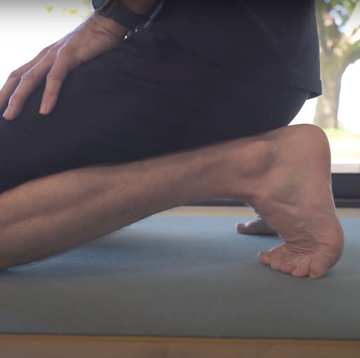These muscles may be torn at their origin from the pelvis or in their bulk on the inside of the thigh.
Symptoms
In an acute tear there is sudden pain over these areas, which probably occurred as your foot slipped sideways or outwards, as when crossing a steeplechase hurdle. Because the muscles stabilise the hip, continued running will be painful.
Signs
There may be a tender swelling where the muscle was injured, and any action which holds the knees together will be painful. Outward movement of the hip will be restricted by spasm and pain. Complete ruptures are uncommon.
Medical investigation
The simple test of the doctor trying to part the knees while the patient is lying flat is usually the only investigation required, unless further damage is suspected in an elite sportsperson, when an ultrasound or muscle scan might be applicable.
Best winter running gear?
This is where the difficulties start, as the symptoms may be very similar to those experienced where the pubic bones meet at the front of the groin, or where you have suffered a so-called sports hernia. Osteoarthritis of the hip joint may also refer pain to the inner thigh.
Self-treatment
How to recognise them, how to overcome them RICE, but it is by far the most appropriate treatment in the early stages. You should not deviate from its use, continuing the treatment during rehabilitation. The most effective exercise to stretch the muscles safely resembles the yogic lotus position.
Medical treatment
A doctor and a physiotherapist will be able to guide appropriate stretching while electrical treatments are used, and advise on the use of optimum stretching required before strength is gained, using exercises which pull the knees together.
Can you run through it?/Recovery time
My personal experience of attempting to run through an adductor injury was to lose six months of youthful running, thanks to inexperience. These injuries are slow to heal and over-enthusiasm may again risk scar tissue changing to bone. It is far better to write off two months during which you rehabilitate properly, than to risk many more with inappropriate treatment.
Trochanteric Bursa
Runners’ pain over and below the bony outer part of the hip joint is frequently diagnosed as a bursa forming with discomfort in the outer buttock and thigh. Some of the discomfort may well be due to tautness of the iliotibial band, whose other end we met on the outer side of the knee. All this muscle is contained within the inelastic stocking-like fascia lata – the reason that our thigh muscles don’t sag like those in the belly!
Symptoms
There is an increasing ache over the bony trochanter of the hip, which becomes painful with extra mileage. Pain may radiate down the thigh at night, while rolling the straight-kneed leg inwards will increase the pain.
Signs
The doctor should be able to put his finger on the pain over the bone, but a simple test, whereby you lie on your good side and attempt to lift the affected side upwards against resistance (abduction) will undoubtedly worsen the pain. Sometimes the irritation gives rise to crepitus, the crackling sensation that occurs with movement.
Best winter running gear?
It is necessary to rule out hip arthritis, back and nerve conditions, as well as muscle injuries to the gluteals within the buttock, to confirm the diagnosis. However, little else in the area will actually be sore to touch.
Self-treatment
If it’s bad enough to stop you running, RICE will only have a marginal effect upon treatment.
Medical treatment
Depending on the severity of the condition, treatment with ultrasound may be effective. However, if the condition shows any signs of becoming chronic, a steroid injection will have the greatest chance of producing a cure.
Can you run through it?/Recovery time
Limping through an injury like this may well be forerunner of secondary injuries and should be avoided. Running may well be possible within two weeks of a steroid injection, but you should always follow the advice of your medical professional.













